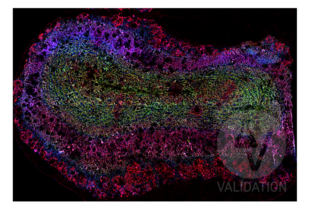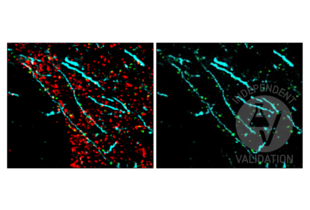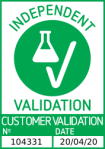DLG4 anticorps
-
- Antigène Voir toutes DLG4 Anticorps
- DLG4 (Discs, Large Homolog 4 (Drosophila) (DLG4))
-
Reactivité
- Rat
-
Hôte
- Souris
-
Clonalité
- Monoclonal
-
Conjugué
- Cet anticorp DLG4 est non-conjugé
-
Application
- Western Blotting (WB), Immunohistochemistry (IHC), Immunofluorescence (IF), Immunocytochemistry (ICC), Antibody Array (AA), Multiplex Immunohistochemistry (mIHC)
- Specificité
- Detects ~100 kDa. An additional protein of >100 kDa is also detected. Additional cross-reactive bands are detected at ~75 kDa and 50 kDa in rat and mouse samples.
- Réactivité croisée
- Boeuf (Vache), Humain, Souris, Rat
- Purification
- Protein G Purified
- Immunogène
- Recombinant rat PSD-95
- Clone
- 6G6
- Isotype
- IgG2a
-
-
- Indications d'application
-
- WB (1:250)
- IHC (1:1000)
- ICC/IF (1:100)
- optimal dilutions for assays should be determined by the user.
- Commentaires
-
1 μg/ml was sufficient for detection of PSD-95 on 20 μg rat brain tissue extract by ECL immunoblot analysis using Goat Anti-Mouse IgG: HRP as the secondary.
- Restrictions
- For Research Use only
-
- by
- Akoya Biosciences
- No.
- #104331
- Date
- 20.04.2021
- Antigène
- DLG4
- Numéro du lot
- MP686150
- Application validée
- Multiplex Immunohistochemistry
- Contrôle positif
Fresh frozen mouse olfactory bulb
- Contrôle négative
Unlabeled control (mouse fresh frozen)
- Conclusion
Passed. The anti-DLG4 antibody ABIN361694 specifically labels areas that contain high levels of post-synaptic boutons; these are located throughout the murine olfactory bulb and are concentrated in the glomerular layer.
- Anticorps primaire
- ABIN361694
- Anticorps secondaire
- Full Protocol
- Protocol details are described in the Akoya Biosciences CODEX® User Manual (see https://www.akoyabio.com/wp-content/uploads/2021/01/CODEX-User-Manual.pdf).
- Tissue preparation as outlined in the Akoya Biosciences CODEX® User Manual fresh-frozen tissue protocol.
- Conjugation of the anti-DLG4 antibody ABIN361694 to an oligo barcode used to bind oligo-conjugated fluorophore ATTO 550.
- Notes
No signal was detected in unlabeled specimens.
Specific staining of DLG4 was also observed with human FFPE cortical tissue sections with both citrate antigen retrieval and EDTA antigen retrieval.
Optimal staining and signal to noise ratios were obtained if tissue was pre-treated for enogenous tissue autofluorescence removal (see https://www.akoyabio.com/wp-content/uploads/2020/07/Customer-Demonstrated-Protocol-Autofluorescence-Quenching-Mar2020.pdf).
Validation #104331 (Multiplex Immunohistochemistry)![Testé avec succès 'Independent Validation' signe]()
![Testé avec succès 'Independent Validation' signe]() Validation Images
Validation Images![Murine fresh frozen coronal olfactory bulb section (Thickness = 5 µm) labeled with anti-DLG4 antibody ABIN361694 (red; bound to fluorophore ATTO 550). Labeling is present throughout olfactory bulb layers with a strong degree of labeling in the glomerular layer; this is consistent with the large number of postsynaptic targets within the glomerular neuropil. Slc17a7 and Map2 were labeled with ABIN1027710 (green; bound to fluorophore ATTO 550) and ABIN125739 (blue; bound to fluorophore ATTO 550).]() Murine fresh frozen coronal olfactory bulb section (Thickness = 5 µm) labeled with anti-DLG4 antibody ABIN361694 (red; bound to fluorophore ATTO 550). Labeling is present throughout olfactory bulb layers with a strong degree of labeling in the glomerular layer; this is consistent with the large number of postsynaptic targets within the glomerular neuropil. Slc17a7 and Map2 were labeled with ABIN1027710 (green; bound to fluorophore ATTO 550) and ABIN125739 (blue; bound to fluorophore ATTO 550).
Murine fresh frozen coronal olfactory bulb section (Thickness = 5 µm) labeled with anti-DLG4 antibody ABIN361694 (red; bound to fluorophore ATTO 550). Labeling is present throughout olfactory bulb layers with a strong degree of labeling in the glomerular layer; this is consistent with the large number of postsynaptic targets within the glomerular neuropil. Slc17a7 and Map2 were labeled with ABIN1027710 (green; bound to fluorophore ATTO 550) and ABIN125739 (blue; bound to fluorophore ATTO 550).
![FFPE normal human cortex tissue section labeled with anti-DLG4 antibody ABIN361694 (green; bound to fluorophore ATTO 550) after EDTA antigen retrieval. MAP2 and Synapsin were labeled with anti-MAP2 antibody ABIN125739 (cyan; bound to fluorophore ATTO 550) and anti-SYN1 antibody ABIN5542390 (red; bound to fluorophore AF488).]() FFPE normal human cortex tissue section labeled with anti-DLG4 antibody ABIN361694 (green; bound to fluorophore ATTO 550) after EDTA antigen retrieval. MAP2 and Synapsin were labeled with anti-MAP2 antibody ABIN125739 (cyan; bound to fluorophore ATTO 550) and anti-SYN1 antibody ABIN5542390 (red; bound to fluorophore AF488).
Protocole
FFPE normal human cortex tissue section labeled with anti-DLG4 antibody ABIN361694 (green; bound to fluorophore ATTO 550) after EDTA antigen retrieval. MAP2 and Synapsin were labeled with anti-MAP2 antibody ABIN125739 (cyan; bound to fluorophore ATTO 550) and anti-SYN1 antibody ABIN5542390 (red; bound to fluorophore AF488).
Protocole -
- Format
- Liquid
- Concentration
- 1 mg/mL
- Buffer
- PBS pH 7.4, 50 % glycerol, 0.09 % sodium azide, Storage buffer may change when conjugated
- Agent conservateur
- Sodium azide
- Précaution d'utilisation
- This product contains Sodium azide: a POISONOUS AND HAZARDOUS SUBSTANCE which should be handled by trained staff only.
- Stock
- -20 °C
- Stockage commentaire
- -20°C
-
- Antigène
- DLG4 (Discs, Large Homolog 4 (Drosophila) (DLG4))
- Autre désignation
- PSD95 (DLG4 Produits)
- Synonymes
- anticorps 11, anticorps CG1725, anticorps CG1730, anticorps CPD, anticorps DLG, anticorps DLG-A, anticorps Discs-large, anticorps Dlg, anticorps Dlg-A, anticorps Dlg1, anticorps DlgA, anticorps Dmel\\CG1725, anticorps Drodlg, anticorps PSD95, anticorps SAP97, anticorps anon-EST:Posey93, anticorps anon-WO03040301.258, anticorps anon-WO03040301.260, anticorps anon-WO03040301.268, anticorps d. lg.-1, anticorps dlg, anticorps dlg-1, anticorps dlg-A, anticorps dlgA, anticorps dlgS97, anticorps l(1)10Bf, anticorps l(1)G0276, anticorps l(1)G0342, anticorps l(1)G0456, anticorps l(1)G19, anticorps l(1)L11, anticorps l(1)bwn, anticorps l(1)d.lg-1, anticorps l(1)d.lg.-1, anticorps l(1)discs large, anticorps l(1)dlg, anticorps l(1)dlg-1, anticorps l(1)dlg1, anticorps l(1)l.pr.-2, anticorps l(1)lpr-2, anticorps misb, anticorps dlgh4, anticorps psd95, anticorps sap90, anticorps sap-90, anticorps LLGL1, anticorps Dlgh4, anticorps PSD-95, anticorps SAP90, anticorps SAP90A, anticorps Sap90, anticorps SAP-90, anticorps DLG4, anticorps discs large 1, anticorps discs, large homolog 4, anticorps discs large MAGUK scaffold protein 4, anticorps discs, large homolog 4b (Drosophila), anticorps discs, large homolog 4 (Drosophila), anticorps dlg1, anticorps dlg4, anticorps DLG4, anticorps dlg4b, anticorps Dlg4
- Sujet
- Postsynaptic Density protein 95 (PSD95), also known as Synapse associated protein 90 kDa, is a member of the membrane-associated guanylate kinase (MAGUK) family of proteins. PSD95 is a scaffolding protein and is involved in the assembly and function of the postsynaptic density complex (1). These family members consist of an N-terminal variable segment followed by three amino-terminal PDZ domains, an upstream SH3 domain and an inactive carboxyl-terminal guanylate kinase (GK) domain. The first and second PDZ domain localize NMDA receptors and K+ channels to synapses, and the third binds to neuroligins which are neuronal cell adhesion molecules that interact with b-neurexins and form intercellular junctions. PSD-95 also binds to neuronal nitric oxide synthase, possibly through interactions between PDZ domains present on both proteins (2). Thus different PDZ domains of PSD-95 might be specialized for distinct functions (3, 4). PSD95 participates in synaptic targeting of AMPA receptors through an indirect manner involving Stargazin and related transmembrane AMPA receptor regulatory proteins (TARPs) (5). The protein is implicated in experience dependent plasticity and plays an indispensable role in learning (6). Mutations in PSD95 are associated with autism (7).
- ID gène
- 29495
- NCBI Accession
- NP_062567
- UniProt
- P31016
- Pathways
- Regulation of Muscle Cell Differentiation, Synaptic Membrane, Skeletal Muscle Fiber Development, Asymmetric Protein Localization, Regulation of long-term Neuronal Synaptic Plasticity
-



 (1 validation)
(1 validation)



